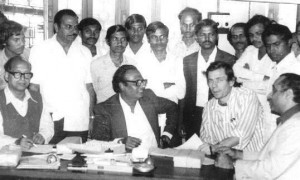50 years of mobilizing frontline health workers

By Bob Gillespie, Population Communication
I recently returned from Bangladesh where, as a Ford Foundation consultant from 1975 to 1978, I helped select, train, mobilize, supervise and evaluate 6,700 traditional birth attendants (TBAs), 13,500 Dais (village midwives), 13,500 family welfare attendants, 2,722 male family welfare visitors and 18,000 female family welfare workers. The visit let me reflect on the amazing work I have seen first-hand frontline health workers (FHWs) in improving reproductive, maternal and child health all over the world and on the great value that support from both the public and private sectors in the United States in support of these workers.
 Robert Gillespie working with Family Welfare Visitors in Bangladesh
Robert Gillespie working with Family Welfare Visitors in Bangladesh
FHWs in Bangladesh promoted contraceptive services, combined with maternal and child health services. Most of the FHWs were between 30 and 35 years old, married with around two children, actively practicing contraception, and from the villages or urban areas in which they conduct home visits and develop community-based services. Extensive research was conducted using knowledge, attitude and practices surveys of women and men in the reproductive age group, follow-up surveys on contraceptive practices, pretesting communication and education techniques and utilizing coupons, and daily and monthly record forms. Continuous supervision reinforced with mass media and policy support provided measurable results. After extensive fact-finding and mapping, the criteria for assigned populations were based on visiting each household twice a year.
On November 11, 2011, Dr. Ghulam Nabi Azad, the Minister of Health and Family Welfare of India, presented a compendium of country specific reports I commissioned on population stabilization from Bangladesh, India, Ghana, Kenya, Mali, Nigeria, Senegal, Uganda, and Zimbabwe at the Partners in Population and Development (PPD) meeting in Dhaka, Bangladesh. The book, "Population Trends and Policy Options in Selected Developing Countries," includes a chapter authored by Atiqur Rahman Khan and Mufaweza Khan that describes Bangladesh’s family planning program. The total fertility rate in Bangladesh has dropped from 6.3 in 1974 to 2.3 today.
The FHWs in Bangladesh have successfully integrated their sexual and reproductive health focus with all aspects of development, including credit programs pioneered by the Grameen Bank, cooperatives and literacy programs.
In 1962, I was a consultant to CARE and arranged for training FHWs in northern Luzon in the Philippines. As a Pathfinder consultant in Hong Kong in 1963, I trained family planning field workers in the block resettlement areas. As the resident representatives of the Population Council in Taiwan from 1964-65, I was the principal consultant on selection, training, development of working procedures, supervision, and evaluation of family planning fieldworkers. In Iran, I helped mobilize the family planning fieldworkers, who are the backbone of the national health policy, resulting in the decline of the total fertility rate from 5.3 in 1971 to 1.9 today. UNESCO published a manual that chronicles the action and evaluation procedures.
The FHWs have successfully established depot distribution of contraceptives using satisfied users. They have facilitated both surgical and nonsurgical services, including the use of mifepristone and misoprostol, manual vacuum aspiration, implants, inter-uterine contraceptives, emergency contraceptives, injectibles, surgical tubal occlusion using a laparoscopic procedure and mini-laparotomy, and promoted no-scalpel vasectomies. To utilize all public and private health providers within their capabilities or qualifications after training, a fee-for-service reimbursement allows for all methods to be stressed according to the needs of couples. Coupons and follow-up surveys have assisted in management and arranging payments. The fieldworkers learn the importance of postpartum contraceptive use, community-based distribution and the potential of social marketing.
Mobile technologies now have an application that uses text messages to provide alerts and reminders, actionable information and advice, and educational information directly to pregnant women to help ensure proper prenatal and neonatal care. The application helps record and track the care delivered to women and newborns. Mobile health applications allow cell phones to be used as instruments to communicate to the public, to inform health providers of the latest advancements in contraceptive technology, and enhance the skills of FHWs to systematically measure contraceptive supply inventories.
Families have welcomed FHWs for the skills they bring to the doorstep. I have stressed the importance using the word "love" at least three times during each visit. Helping to mobilize and supervise frontline health workers for 50 years has been a gratifying, exciting, a privilege and, if done properly, a whole lot of fun.
